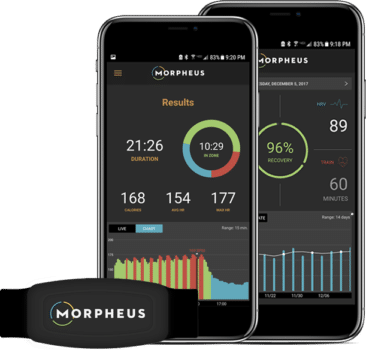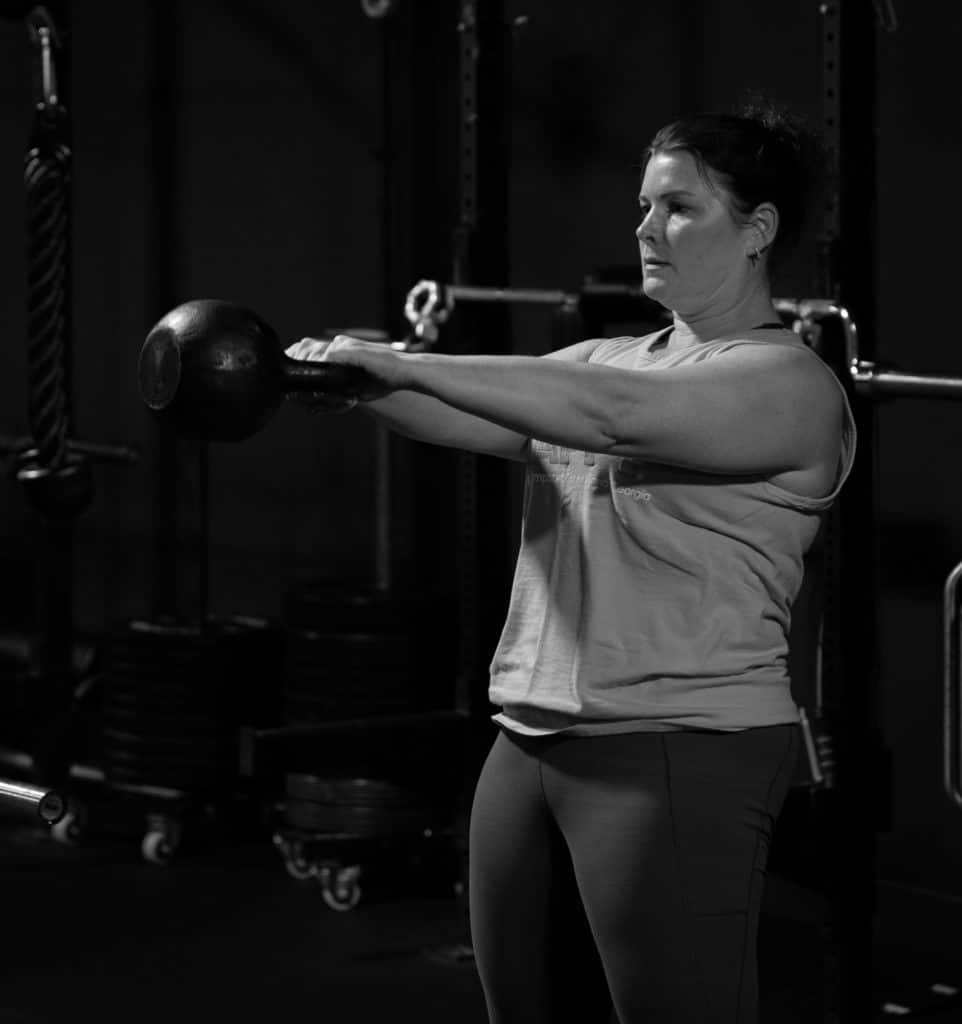My friend Jordan said something to me the other day that I want you to remember. I want it to become a refrain that plays over and over in your head. And I want you to keep it in mind as you read the rest of this article. The philosophy behind the statement sums up everything you’re about to read and just about everything that matters when it comes to training. Here it goes:
You can’t out train your recovery.
No matter what an OrangeTheory trainer tells you, you can’t just HIIT your way into fitness. You need a balanced approach that addresses all aspects of fitness. That balance includes the right volumes and intensities of mobility, power, strength, and conditioning. And you need to gain the understanding of how your training and your lifestyle mesh. Otherwise, you under train or you walk yourself into trying to out train your recovery.
At Beyond Strength we use a training and recovery system called Morpheus to help our members monitor their recovery and train at the correct intensity. When used correctly, it is dang near invaluable. You learn how to balance training and lifestyle so that you recover to get the most out of your training. As a result, all aspects of your fitness improve.
This quick read walks you through Morpheus: what it is, why we chose to use it, and how to effectively use it to improve your recovery and your fitness.
What is Morpheus?
Morpheus is an app-based training and recovery tool that factors heart rate, heart rate variability, training duration and training intensity. It uses two different heart rate straps, one for training and one for recovery testing. It calculates your recovery based on a daily heart rate variability reading, subjective workout difficulty ratings, and lifestyle data it pulls in from third party apps like Oura, Whoop, or the health app on your iPhone.

All of that information congeals into a recovery score and a re-zoning of your heart rate training zones for the day. The re-zoning is muy, muy importante. If you’re recovery score is high, your heart rate training zones shift toward the higher end of your personal spectrum. If your recovery score is low, Morpheus shifts your zones lower so that you don’t train at too high of an intensity. This is to ensure that you give yourself a training load that you’ll be able to recover from and don’t dig yourself deeper into a recovery debt. Let’s talk more specifically about the zones.
Morpheus has three training zones: The Blue Zone, The Green Zone, and The Red Zone.
The Blue Zone
The blue zone encompasses low to moderate training intensities. Morpheus calls it the “recovery zone.” Training in this zone does a couple of things for you. It builds the raw materials of your recovery system. Things like capillary density in your muscles, regulation of your parasympathetic nervous system, and improved cardiac output. These are also some of the main raw materials for building aerobic capacity. If you want to build aerobic fitness, which you should because it is the bedrock of endurance and longevity, you should spend most of your time training in this zone.
The Green Zone
Morpheus calls this the “conditioning zone.” This is mostly the aerobic power training zone. That means it trains your aerobic energy system to produce energy faster – meaning that you’re sending more oxygen through your body. Anaerobic metabolism kicks in as you creep toward the higher end of the green zone. The more time you spend in the higher end of the green zone, the quicker you’ll wear out. Most of your green zone efforts should be in the low to middle parts of the zone. And you don’t need a ton of time in the green zone for it to be an effective training session. According to Morpheus – and we’ve also found this to be true – 20% to 40% of your high-intensity conditioning sessions should be spent in the green zone. The rest should be in the blue zone.
The Red Zone
The red zone is the highest intensity training zone. When you’re in the red, you’re mostly running on anaerobic metabolism. That means you’ll generate energy fast, quick, and in a hurry. But you’ll fatigue in the same way. Spending a lot of time in the red zone also limits your ability to recover. That level of intensity takes a high tax from your body and requires more down time and more resources before you’re ready to train again. It’s important to tap into the red zone every once in a while, to improve your fitness, but you need very little time there. Less than 10% of your training should be in the red zone.
More About the Zones
Not only do the zones move with you based on your recovery. But they also adjust as your fitness improves. As you get fitter, each training zone adjusts to a higher percentage of your max heart rate. For example, your blue zone expands to include slightly higher heart rates. It sounds simple, but it’s a profound feature that contributes to making you fitter. And there is no other widely accessible training and recovery tool that does it.
Why Did we Decide to Use it at Beyond Strength?
“Clarity is a hell of a drug.”
Chris Merritt, aka my “mini me,” has said this a thousand times in a hundred contexts. It holds true across the board, especially with training.
We’ve watched so many members over the years make mistakes and slow their progress out of ignorance. They just didn’t realize how their lifestyle was fucking up their training results. Or, more accurately, they were able to rationalize their lifestyle inspite of how it was messing up their training because they didn’t have objective data slapping them in the face.
We needed to offer members a nice, kind slap in the face to improve their awareness and their recovery. It’s a great behavior modification tool. Many times, people need to be hit with the truth before they’ll change. They need the truth put right in front of them.
On top of that, we wanted to give our members the best training available. We train active people that like being coached and enjoy challenging themselves. Dialed in training helps them get the most out of their active lives. Morpheus offered us the opportunity to ensure our folks are training at the right intensities.

That means it helps us improve our coaching. We can guide people during class because we see their heart rate zones in real time. We see our members’ recovery scores and can use them to guide how intensely they train that day. And it’s a gateway into conversation about behavior change. For example, if your heart rate jumps as soon as you start to move, it could be that your fitness needs to improve. Or it could be that you’re dehydrated because your water intake is piss poor. When we see that heart rate jump, we can ask questions that we otherwise wouldn’t have the insight to ask.
Fitness is a long game, and we want our members to approach it that way. Having data, monitoring training and recovery, and seeing objective improvements over time helps people play the long game.
But the entirety of our why culminates in a simple refrain that I’ve asked you to remember:
You can’t out train your recovery.
How Do We (and should you) Use it?
This section could be one sentence:
Use it as it’s intended to be used.
But since I’m not a total douche canoe, I’ll expand on that.
Do the recovery test every day before you train. Do it at the same time and in the same way. Your recovery score guides your training intensity for the day. It’s imperative that you train at the proper intensity to ensure long-term progress and lasting results. Your recovery score is also a snapshot of how your current lifestyle and training are meshing. It might tell you that you need more sleep or that you need to focus more on drinking water. It might tell you that you’ve been training at too high of an intensity or that glass of wine every night before bed isn’t doing you any favors. The recovery test is the foundational element of the system. You have to do it to get the most out of Morpheus and your training.
Also, be sure to sync up the data from your third-party apps like Oura or Whoop. Morpheus can use this data when it factors your recovery score.
When you choose a training style in the app, choose cardio if you’re doing a purely cardio workout. If you’re doing a lifting session, choose mixed that way you can still see the colors of your heart rate zones while training. That information isn’t always imperative, but it can be helpful to know how much a certain workout is costing you in terms of intensity.
Next up is staying in the prescribed zones during class. If the instructions are to stay in the blue zone, stay in the gaht dang blue zone – no matter how much you have to slow down to stay there. This is the part where matching training intensity to your recovery score and the program prescriptions all meet. You can’t out train your recovery. Training intensity must match recovery.
Once you finish up your training session, mark off the subjective rating scale in the Morpheus app. Morpheus uses that data to calculate your training load and recovery score. We have to give the system as much data as possible for it to give us accurate feedback.
Summing it up
Training isn’t just about doing brutally hard things. It’s about doing the right things, at the right times, and at the right intensity. Morpheus is a great tool that helps us do all of that. Use it the right way and use it consistently and it will help to improve your long-term results by keeping your training dialed in. Because remember, you can’t out train your recovery.
You might also like:
- START NOW: WHY WAITING FOR THE PERFECT TIME IS THE WORST THING TO DO
- HOW TO CHOOSE THE RIGHT DEADLIFT VARIATION
- HOW TO BE INTELLIGENT WITH YOUR WEIGHT SELECTION
- HOW TO PROGRESS YOUR WEIGHTS DURING A STRENGTH PROGRAM
- WHY YOU’RE DOING WHAT YOU’RE DOING: FEBRUARY 2023 PROGRAM BLOG
- HOW (AND WHY) OUR YEAR-LONG TRAINING PLAN WORKS
- WHY WE TEST AR BEYOND STRENGTH
- TIPS FOR COMPETING WITH YOURSELF IN THE GYM
- HOW TO SET GOALS FOR 2023
- HOW MANY REPS SHOULD YOU DO? (Spoiler alert, it matters in more ways than you think)
- LET’S SEE HOW GREAT I CAN DO THIS
- HOW TO RECOVER FROM YOUR WORKOUTS
- FITNESS: THE INFINITE GAME
